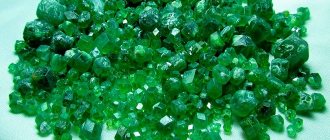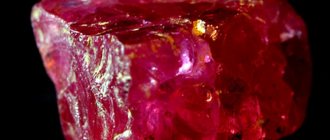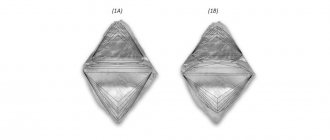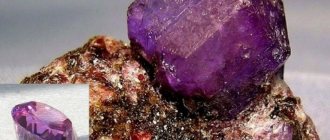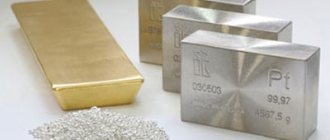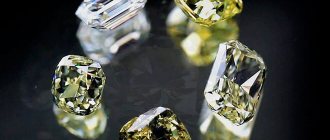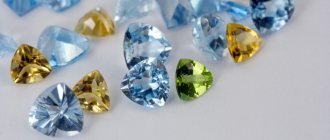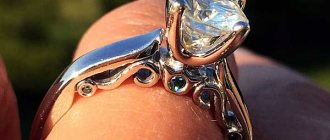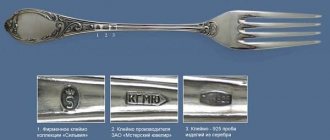Precious minerals, due to their splendor and radiant shine, have always attracted the eyes of people and become objects of admiration. However, what makes stones so expensive is not only their external beauty, but also their rarity. The cost of unique specimens reaches sky-high levels.
An equally important parameter for setting the price is the weight of the mineral. To measure the mass of precious stones, a non-standard unit is used - the carat, which is well known to jewelers. However, for an uninformed person, the weight of a carat in grams remains a mystery, so before buying expensive jewelry inlaid with diamonds or sapphires, you should know how much one carat weighs and how to determine the number of grams in a gem.
What is carat
To measure the mass of precious stones, the carat is used - a unit that has the designation ct and is equal to 0.2 grams. In England, the same value is used to determine the percentage of gold in the setting, but in this case the unit is abbreviated “K”.
It is important to note that the size of a gem is not measured in ct, since this is a unit of mass, not dimensions. In addition, the parameters of the jewelry insert largely depend on the cutting method by which the crystals take shape.
To determine the cost and value of a mineral, one must know how many cts are contained in a particular sample. When purchasing, do not forget that purity also affects the price, so more does not always mean better.
How to determine the carat value of a diamond?
There are several ways to determine the carat value of a diamond:
- weighing;
- according to the formula;
- using special tables.
Each method determines carat content with some degree of accuracy.
The weight of small pebbles is estimated by weighing. For this purpose, special scales are used - microscales. The precision of diamond weighing is determined to thousandths. In the same way, you can determine a diamond of 3 carats, 1 carat, or the weight of medium stones.
Today on the market the cost of a 1-carat diamond of the highest quality reaches 20 thousand dollars.
To determine the price of a gemstone, the cost per unit of measure should be multiplied by its weight.
History of the unit
The history of the origin of the carat as a unit of measurement goes back to earlier times. In the old days there were no scales, so merchants and jewelry dealers had difficulty selling jewelry by original weight. A unified measurement system was invented that compares the size and mass of minerals.
To determine the weight of gems, grains of carato, a ceratonia plant that grew in the area where mineral mining took place, began to be used. In other countries, acacia grains were used as weights. However, the name “carat” owes its appearance to ceratonia. The fact is that the fruits of this tree had the same mass - 0.19 grams - regardless of the place of growth and time.
The measurement was officially agreed upon in 1907 during the Fourth General Conference.
In the USSR, official approval was received in 1922. From that moment on, the mass of jewelry began to be determined in ct.
Kinds
In the modern world, there are two types of units for measuring the mass of jewelry - metric and assay carat. The first is a measure of the weight of precious stones, the second determines the purity of the gold alloy.
Metric
The metric carat is a unit of measure adopted in all developed countries. Metric cts are used to measure the mass of unique and dazzling diamonds. The history of the origin of the unit of measurement goes back to antiquity, where the mass of minerals was determined using ceratonia fruits, which have an identical weight - 189 mg.
Difficulties began when traders discovered that the fruits differed in different countries. This created inconvenience and caused conflicts between merchants. As a result, the idea of adopting a single unit of mass arose, but this was opposed by Great Britain, which adhered to its metric system. Despite the difficulties, the jewelers soon agreed on a single ct - 0.2 grams.
Assay
This type is different from the metric carat and denotes a measure not of weight, but of the purity of the gold alloy. The hallmark carat was invented in Ancient Rome, when the emperor introduced a gold coin that weighed 24 K. A similar coin is still in active circulation in Great Britain. Other countries prefer to use percentages, for example, the 585-carat designation indicates that the jewelry contains 58.5% pure gold.
When using an assay unit to determine the purity of gold, the following ratio is taken: 24K is the pure metal content. Therefore, a piece containing half gold would be 12K. In Russia, the jewelry industry produces jewelry with hallmarks of 750, 585, and 375—18, 14, and 9 K, respectively.
The relationship between the weight and size of the stone
There is a misconception that the weight of a gemstone characterizes its size. But the physical and chemical nature of minerals is designed in such a way that different gems of the same weight have different sizes due to different densities. Compared to a diamond, a one-carat sapphire or ruby will be smaller in size, but an emerald will be larger.
Another indicator that determines the size of a stone is its cut. According to this criterion, even diamonds of the same weight differ in size.
These sizes are indicated for cut group A. For other cut groups, sizes may vary slightly.
So, a one-carat diamond will have completely different sizes, depending on the cut:
- Circle. The most popular cut shape. The diameter of this stone is 6.5 mm. Round diamonds, regardless of the number of facets, are the most expensive, since the lion's share of the precious weight is lost during processing.
- "Marquis". A cut that was born thanks to the favorite of the King of France. The diamond, reminiscent of the smile of the Marquise de Pompadour, measures 9.8 * 5.6 mm.
- Square. This shape implies different types of cuts, the most popular of which are “Princess” and “Asscher”. Size – 5.55*5.55 mm.
- Oval. Size – 7.7*5.9 mm. The brilliance of oval diamonds is identical to that of round stones, but the former benefit from their size.
- "Cushion" and "Radiant". Square cut with beveled edges, stone size 6*5.5 mm.
- "Pear". This shape is a tandem of two other shapes – circle and “Marquise”. Size – 8.6*5.8.
- Heart. A cut designed to hide the natural imperfections of a diamond, measuring 6.7*6.5 mm.
- "Baguette". A one-carat stone has a size of 7.7 * 4.5 mm. The brilliance of a piece of this shape outshines the brilliance of round diamonds.
- Emerald. Size – 6.4*4.9 mm. This type of cut is only suitable for flawless stones. Otherwise, this form will highlight all the shortcomings. Emerald shapes shine brighter than round ones, but the latter better convey the play of color.
Also read: Jewelry with Sultanite
Stone sizes
If we talk about the weight of diamonds, then the carat plays a decisive role only in the evaluation of small stones. When determining the cost of large specimens, first of all, they take into account the indicators of purity and color.
Stone purity table
Diamond Color Chart
Difference between gold and diamond carats
To answer the question of how diamond carats differ from gold carats, it should be understood that these two definitions are used for different purposes:
- Diamond (metric) carats are used to indicate the weight of minerals, which include famous diamonds. The weight of one carat is 0.2 grams, the designation is ct.
- Gold (assay) standards determine the amount of pure gold and have the abbreviation K. In some countries, for example, in Russia, jewelry is made with hallmarks that can easily be converted to K.
The system for measuring the weight of gems and the gold content goes back to ancient times and is still used today. In the jewelry industry, carat scales with minimal error are used to determine weight in grams. To calculate carat content, there are many tables with the help of which even a person ignorant in this area can calculate the number of grams.
How many grams in one carat
At the beginning of the 20th century, jewelers agreed on the exact number of grams in a carat. In 1907, they decided to equate the weight of one carat to 0.2 grams. However, not all countries agreed to convert the mass into carats, continuing to use their own values. The countries adopted a unified standard in the following sequence:
- France - 1907
- Holland - 1911
- USA - 1913
- USSR - 1923
Following these states, other countries also decided to convert grams to carats. However, a 1 ct gem is a rare and expensive stone. Much more often you come across crystals with a smaller mass, not reaching 0.2 grams. But here, too, jewelers did not use standard measures and created their own unit - the point. It has been established that one ct (0.2 grams) is equal to 100 points.
Carat price of gemstones
Today, precious stones and jewelry with them are considered not only an attribute of secular society, but also a profitable financial investment. Some minerals reach values of tens and hundreds of thousands of dollars. Diamonds remain at the price peak, although some rare minerals are confidently ahead of diamonds in this struggle for leadership.
Top five gems
Despite the large number of scientific classifications of minerals, based on various characteristics, there is still no clear division of stones. After all, sometimes a flawless rare gem is several times higher than the cost of a diamond of poor quality. However, a conventional five precious minerals have been identified that top the list of the most expensive stones:
- Diamond. The cost of 1 carat of diamond starts at 15 thousand dollars, determined by a number of criteria. But there are also so-called “folk” diamonds - stones of 0.1 ct that cost about 10,000 rubles. Carbonado, a black diamond with an average price of $150/ct, is considered inexpensive. The best stones reach 500-600 $/ct.
- Emerald. Estimated from $350/ct. This refers to the lowest quality stones. An emerald with ideal characteristics starts at $8,500/ct, increasing in price in proportion to the size of the nugget - a top-quality cut emerald weighing 5 carats or more costs about $15,000/ct.
- Ruby. Low quality red corundums sell for $100/ct. But if a red nugget is assessed as flawless, then the price per carat of such a stone soars to 15 thousand.
- Sapphire. The most expensive is cornflower blue corundum. The heated mineral sells from 300 to 1000 $/ct. A mineral that cannot be heat treated starts at $1000/ct. The orange Padparadscha sapphire is considered a rare gem. Its price starts from 130 $/ct. A collectible piece weighing 5 carats or more can cost about $30 thousand.
- Alexandrite. A stone weighing 3-5 carats of lower quality sells for 600-2500 dollars. The best specimens cost up to $22,000/ct. The record price for a carat of Russian alexandrite sold at auction was $70,000.
Also read: 10 most popular red minerals
The five stones that top the lists of the most expensive minerals in the world are not the last selection of beautiful gems that belong to the category of precious stones.
Video about the cost of 1 carat of diamond:
Diamond quality rating:
Popular precious minerals
The list of fascinating stones can be continued indefinitely, but the highest positions are occupied by:
- Tanzanite – average price – $500 per carat. The best samples reach $1000/ct.
- Topaz is the most valuable untreated imperial stone of a yellow hue, estimated at 70-500 $/ct, pink - from 500 to 3500 $/ct.
- Sultanite – green palette – 100-150 $/ct. Complex color combinations are twice as expensive.
- Demantoid – 200-300 $/ct. Large specimens reach $1000 per carat.
- Corundum - depending on the variety and quality - from $50-100 to several tens of thousands per carat.
- Noble spinel – the price starts from 20-30 $/ct, reaching 1000 $/ct for rare specimens.
- Amethyst – from 20 to 100 $/ct.
- Rauchtopaz (smoky quartz) – 900-8000 rubles per stone.
- Garnet – from 600 to 2000 rubles per carat.
Artificial cubic zirconias are very popular - they shine en masse in jewelry, successfully copying diamonds. But their cost is cheap - 10-15 dollars for a bag of 100 pieces of medium-sized stones, 50 dollars for a similar volume of multi-colored raw materials.
How do the mass and diameter of precious gems relate?
Before visiting a jewelry store, a table of the ratio of the diameter, which is measured in millimeters or centimeters, and the weight of the mineral will help you find out approximately the cost of the stone. It is difficult to know the exact weight of a particular specimen, since the gems that go on sale have different cuts. At the same time, the primary goal of every jeweler is to maintain the weight of the original crystal, so gems of the same diameter can weigh differently.
The table will help you understand the intricacies of the relationship between carat and diameter (mm):
| Diameter in mm | Carat weight |
| 4,1 | 0,25 |
| 5,1 | 0,5 |
| 6,4 | 1 |
| 8,2 | 2 |
| 9,4 | 3 |
| 10,4 | 4 |
| 11 | 5 |
| 14 | 10 |
| 16 | 15 |
Similar tables that exist for each jewelry variety of stones allow you to find out the number of grams without removing the precious insert from the ring or earrings.

